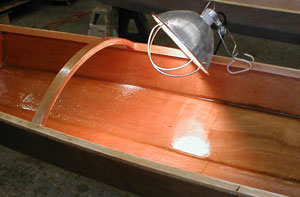Builders' Forum |
|
| ↓ Scroll to Last Comment ↓ | Forum Guidelines | Builders' Forum | |
Hi,
I am building a Wood Duck 12 from plans and so far have been quite pleased with the progress and finish, however, I am not having much success with the glassing. I seem to be getting caugt by all of the pitfalls. Air bubbles (not large but enough that I notice) a grey patch, despite, I thought applying enough epoxy and now I find that I can not fill the weave as the second coat is reticulating and not laying flat, even with sanding. i could sand harder but then I find I am taking the top of the glass to reach the bottom of the cells. This is not the end of the world for the interior, although it will not be acceptable for the outer layer.
I have posted a picture of the reticulation on the build log: https://hattonkayak.wordpress.com/
Any advice appreciated.
Many thanks
Jan
3 replies:
RE: Epoxy problems on Wood Duck
Hi,
I think I understand the problem, I have been warming the epoxy in the belief that this would, by lowering the viscosity, allow it flow better and lay flatter. I think what actually happens is although the epoxy does flow better, it is less tacky and more prone to reticulate. I noticed that even in my plastic trays there was a 'water on wax' effect where it would normally lay level. I have coated the underside of the deck using room temperature epoxy and it is laying fine.
thanks
RE: Epoxy problems on Wood Duck
The "reticulation" you refer to is known in the biz as "orange-peeling." (Personally I like your description better.)
Orange-peeling is always caused by surface contamination of some kind. SOMETHING was on the surface that caused the epoxy to bead up. I could fill pages with the possibilities. I've seen it as a result of kerosene or LNG heater exhaust in the shop, tiny particles of dried silicone lubricant falling from an overhead roll-up door, and microscopic fabric-softener residue from a nearby clothes-dryer vent.
The most common culprit is a wipe-down between coats with a rag that isn't clean (the rag you use to wash the car or wipe off your dipstick oil, for example), or the mistaken use of something like mineral spirits instead of purified solvents like denatured alcohol or lacquer thinner.
By the way, heating your epoxy before application is very common practice in professional shops. We do it here all the time to lower the viscosity. (Just keep in mind that by heating the epoxy you're going to have a less pot-life. Pot-life will roughly halve for every 10 degrees above 70F.) The orange-peel, whatever its cause, is not related to having warmed the epoxy.
Between coats, wipe down with denatured alcohol and a sterile rag. If you think there is some sort of evil contaminate in the air, be sure to flip the rag over often as you clean, so you're not just smearing the mess around.














RE: Epoxy problems on Wood Duck
» Submitted by Laszlo - Wed, 12/23/15 » 8:59 AM
Jan,
I've looked at your picture and don't see anything really wrong, other than maybe the epoxy coat was too thick. A too-thick coat would also explain the little air bubbles.
The first thing I'd recommend is to change how you're filling the weave. I've always had best success with a short nap roller. That lets me put on a very thin layer of epoxy, so there's no drips and each coat is very smooth. Of course, as soon as the coat is on it must be tipped out (I use a dry disposable foam brush) to get rid of the air bubbles left behind by the roller. The downside is that it takes more coats, usually 5 instead of 3, to fill the weave. You also need the rollers and brushes. The advantage is a very smooth coat and a massive reduction in sanding.
The next thing is to consider if you actually want the weave filled, and if so, to what degree. Since most of the interior is invisible, I didn't bother filling that weave. As long as the glass is properly wet out, unfilled weave is as strong and lighter than filled. The only reasons to fill are for cosmetics and comfort (unfilled weave is a wonderful skin abrasive).
To fix your problem area, just sand it down until you are almost into the glass. This will leave a bunch of deep unsanded depressions in a smooth field. Now, just add a thin later of epoxy, let it cure and sand it again. Repeat until the depressions are filled or you've decided that you have better things to do with your time and epoxy than making glass-smooth surfaces where they are not visible. :-)
I don't know if you've run into CLC's shop tips section, but there's a nice section on filling the weave.
Good luck,
Laszlo